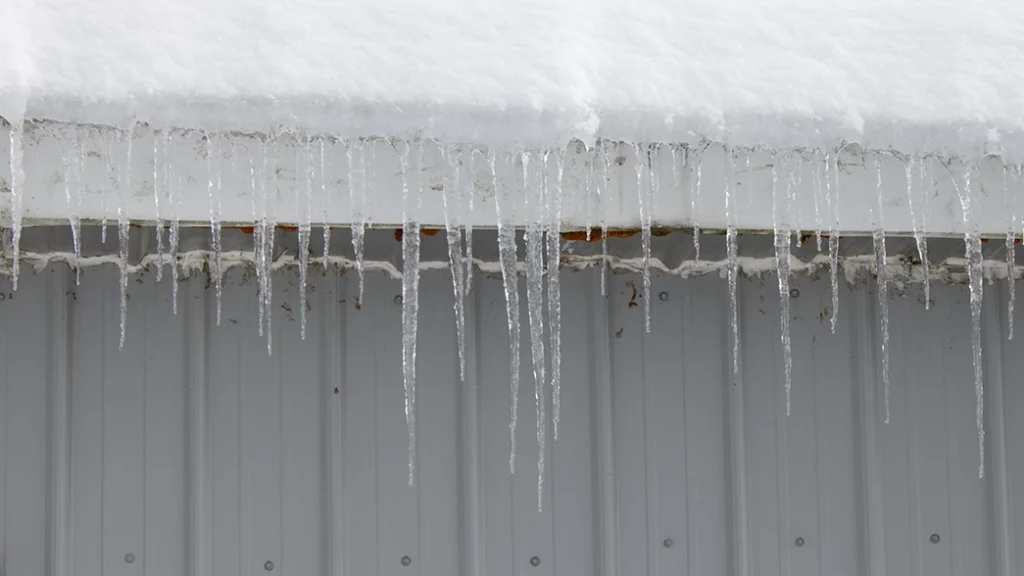Prevent Ice Dam & Preserve Your Commercial Roof
The winter season is upon us in the Northeastern United States, and with the winter months comes snow, ice, and below-freezing temperatures. Although many commercial operations have a snow removal plan in place for their ground operations, facility managers don’t usually give much thought to their commercial roof and how they should care for it.

Depending on the type of commercial building roof type you have, snow and ice can have a very negative impact on your facility. The most significant problem that can occur is an ice dam, which forms at the edge of a roof and prevents melting snow (water) from draining. In this article, we will explain what causes ice dams to form, the risks and consequences associated with them, and mitigation strategies to prevent ice dams from forming.
How Ice Dams Form
There are many industrial roof types, such as single-ply, spray foam, metal, shingle, EPDM, cool, tar and gravel, rubber, PO, and flat. After snow accumulates on a roof, it will stay there unless it melts, is removed, or blows away. Snow accumulation can be particularly problematic on a flat roof because if snow remains on a roof, the outside temperature dips below freezing, and the roof has uneven surface temperatures, ice dams can form.
There are five common ways for ice dams to form. The first is when a roof is flat or low-sloped. As a result, water might not drain properly and since it is more prone to pooling, this can lead to a commercial roof leak. The second way is when a roof has a deficient slope or drainage system. If the roof doesn’t have positive drainage and/or the drainage system is malfunctioning, water will remain. The third way is the result of a rooftop HVAC unit. These units generate heat on the underside of a roof which causes the snow or ice underneath and around the unit to melt.
The fourth way ice dams form is due to poor insulation or ventilation in a commercial building. These issues can lead to fluctuations in the roof’s temperature that will cause snow to melt in certain areas. More specifically, higher portions of a roofs outside surface must be above 32 degrees Fahrenheit (freezing) while lower surfaces remain below 32 degrees Fahrenheit. In this case, the snow on a roof’s surface that is above freezing will melt and as it does so, water flows down the roof and reaches the portion of the roof that is below 32 Fahrenheit and freezes, forming an ice dam. In places like the northeast, where temperatures can get warm during the day and dip below freezing at night, the formation of ice dams can continue to occur well into the spring.
Risks and Consequences
Now that you know how ice dams are formed, we are going to examine the risks and consequences involved. If you have a lot of snow on your roof and you don’t get it removed, the weight, the ice, and pooled water can cause stress to the roof structure itself.
The most common issue that occurs as the result of an ice dam is structural damage to your facility, which often results in an emergency roofing repair. Melted, pooling water can infiltrate through your commercial structure, damaging the roofing material, insulation, and structural components inside your operation. Mold and mildew can also form as a result.
Once water has entered your commercial facility, you will need to deal with interior damage and ultimately a commercial roof leak repair. You will also need to address potential water damage to ceilings, walls, insulation, and equipment.
Mitigation Strategies
To prevent ice dams and the issues that can result, it’s important to have a winter commercial roof maintenance plan in place. If you have a flat roof or one that is prone to snow collection, the facility manager should have a roof snow removal plan in place to clear snow and reduce buildup, so the potential for melting and refreezing is eliminated. You should also have a qualified professional like Capital Roof Care conduct a regular routine winter commercial roof inspection. An industrial roof inspection from Capital Roof Care will include:
- Inspecting the roof insulation and ventilation to ensure it maintains consistent roof temperatures
- Reviewing drains, gutters, and downspouts to guarantee they are clear, and water flows correctly
- Checking for loose rivets, bolts, and other components
- Examining seams and cracks for leaks
- Looking at low points where water can pool
- Surveying the entire roofing system to detect signs of movement
- Removing potentially damaging debris
Preventive maintenance and prompt repairs will help ensure you get optimal longevity and value from your roof system. If your facility is consistently struggling with the formation of ice dams, a trusted CRC roofing professional can also suggest alternatives, such as heating cables that can be installed to de-ice and/or prevent ice formation and materials or structures that can enhance drainage, particularly on flat roofs.
By knowing how ice dams form, the risks and consequences involved, mitigation strategies, and having a routine winter roof inspection, you can proactively manage these issues and reduce the risk of ice dams and their associated problems at your commercial facility.
Sources:
https://extension.umn.edu/protecting-home-rain-and-ice/dealing-and-preventing-ice-dams